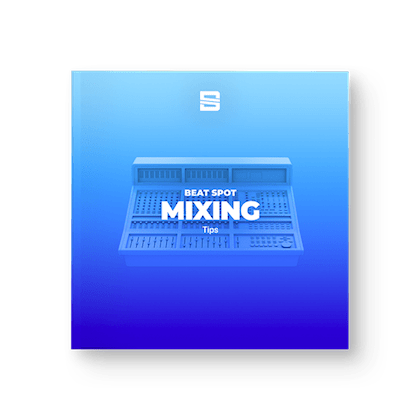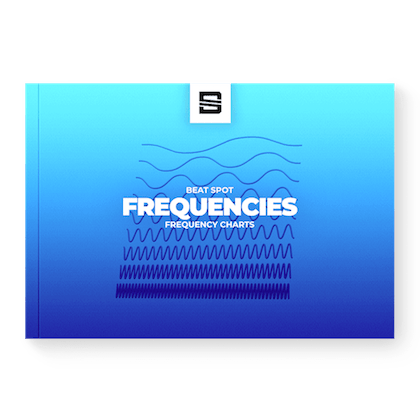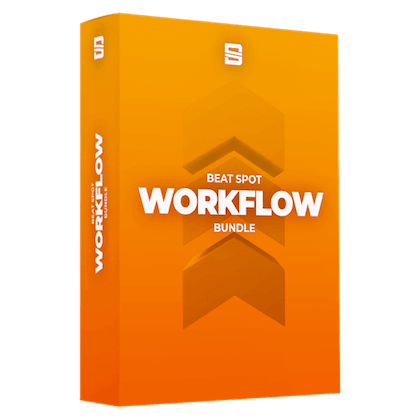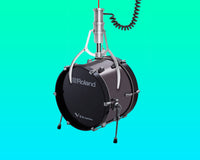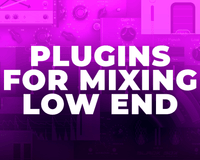Table of Contents
- Establishing a Beat Production Routine
- Should you focus on a specific sound or explore a wide range?
- Quantity vs. Quality
- Quantity can help reach a wider audience
- Quantity allows for bundle deals
- Quality is subjective in beat selling (and art in general)
- Mixing and Mastering for Online Beat Selling
- Preparing the stems for beat selling
- Exporting individual tracks and groups
- Sidechain
- Renaming Files
- Where and how often to place the beatmaker tag?
- File Formats for selling beats online
- Visual Identity
- Sticking to a consistent visual identity
- Following visual trends
- Letting the beat style define each piece of content
- Using online resources
- List of needed assets for selling beats online
- Choosing the store platform
- Pricing
- Is each beat worth the same?
- Setting high prices
- Setting low prices
- Should you go for .99 pricing?
- License types for selling beats
- Uploading beats to social media
- Promotion
- Funnels
- Audience Feedback
- The biggest problems
- Losing the creative flow
- Understanding the audience
- Type beats are often seen as fillers or freestyles
- What if you’re missing clicks due to the beat name?
- Tracking non-legit use
- Other producers might take credit for your work
- Fine-tuning beats to fit the artist (arrangement, BPM, key)
- People often want to be the exclusive user
- You have to wait
- Conclusion
Selling type beats online is a practice that has been around since the early 2010s, but it truly took off in 2016, with "Panda" by Desiigner being one of the earliest and most significant hits to emerge from a beat purchased online. Since then, the online beat selling marketplaces have witnessed several similar success stories. In this article, we'll delve into what it takes to become successful at selling beats online, particularly on platforms like BeatStars and Airbit.
I'll start by sharing my personal journey. I tried my hand at selling beats online and failed, not once but twice, for a variety of reasons. I even invested in a renowned course to improve my skills and understanding of the beat selling business. While it did help me grasp a few marketing strategies, they didn't work for selling beats in my specific case. The total amount of money I earned selling beats online has been close to $100. Considering the time, effort, and money I invested in these beat selling platforms, it has been a net negative.
I'm writing this article with the hope of shedding light on the potential pitfalls of selling beats online. My aim is to provide you with ample information to decide whether this is a viable long-term venture for you. We'll discuss everything from beat licensing, the importance of high-quality beats, the role of beat tags, to the significance of SEO and keyword optimization for beats. Let's delve into the world of online beat selling.
Establishing a Beat Production Routine
How often should you produce beats?
Setting a realistic schedule for producing type beats is crucial, especially if you're not yet a full-time music producer. If you already have a collection of beats on your hard drive, you can start uploading them to beat selling marketplaces and take some time to observe how the market responds.
How much time should you spend per session?
The time you spend per session largely depends on your skills and the complexity of the beats you're producing. More elaborate beats will naturally take more time to craft. Consider making simple beats initially and offer additional custom production services if the client wants more intricate elements.
Should you focus on a specific sound or explore a wide range?
Sticking to a specific sound
Sticking to a specific sound comes with the advantage of being able to quickly produce full beats as you can recycle projects as templates, mix them almost on autopilot, and not worry about following trends. However, the downside is that you might feel creatively stifled and run out of original ideas. Plus, there's the risk of not choosing a sound that's interesting enough to generate a satisfying profit from your efforts.
Exploring various styles
You can test all the niches you want, but you might lose focus quickly and also waste time selecting the right sounds for each new style you're approaching.
Following the trends
Similar to exploring various styles, following the trends allows you to leverage the hype of a given wave. However, you may also face the challenge of being "one of the many" if you don't capitalize on that wave enough. It can also lead to an identity crisis as a beatmaker, making you wonder what your true colors are.
Quantity vs. Quality
Quantity can help reach a wider audience
The law of averages applies to selling beats online. The more beats you produce and upload to beat selling marketplaces, the more chances you have of reaching potential customers.
Quantity allows for bundle deals
Having a large catalog of high-quality beats can help you leverage bundle deals to increase conversions. For instance, if you price your beats at $30 each, you can offer a bundle of twenty beats for $200. This way, your customers get a significant deal, and you still make a substantial profit from a single transaction.
Quality is subjective in beat selling (and art in general)
In the world of online beat selling, you'll find that some beats you love might not perform as well as expected, while others you're less confident in might surprise you with their popularity. Having a larger catalog of beats can help soften the impact of these unpredictable outcomes and ensure a steady stream of content for your audience on platforms like YouTube, BeatStars, and Airbit.
Mixing and Mastering for Online Beat Selling
How much time should you spend per beat?
If you spend around an hour mixing a beat, you might be wasting time on it, especially considering that they’ll eventually be tweaked again or entirely reworked if the client purchases the stems.
Aim for something that can be easily repeatable while being good enough.
Sound selection can make or break this process.
Target volume for beats
Aim for loudness while still retaining the punch in your beats. Consider referencing the best-selling beatmakers out there to get a sense of the ideal volume.
Preparing the stems for beat selling
Aside from exporting the unmastered beat, there are some things to consider if you plan on selling stems.
Exporting individual tracks and groups
The simpler the productions, the easier this process is. Export individual tracks whenever there's no group processing that is essential to the track. There might be times when you have to compromise by exporting the whole group or move some processing to only a few sounds needing it desperately.
Sidechain
Unless it's for stylistic choices, disable sidechain before exporting. There will be times when you will forget it and have to reexport pristine stems. It just happens.
Renaming Files
Having stems properly named is something that will increase your chances of having returning customers. It also makes the lives of engineers a bit easier.
Where and how often to place the beatmaker tag?
To tag or not to tag? Let's hope your beat tag doesn't detract from the beat. Consider using beat tags more as a watermarking tool for showcasing the demo on YouTube, other socials, and your beat store.
File Formats for selling beats online
The mastered beat is often recommended to be exported at 320kbps MP3.
Stems, on the other hand, should at least be 24-bit WAV.
This ensures high-quality beats for your customers on platforms like BeatStars, Airbit, and YouTube.
Visual Identity
Hope you have some decent graphic design skills, or you’ll either look cheap or need to pay some money for a decent identity. You can still rely on cheap templates online, though.
Having a strong visual identity is crucial when selling beats online. If you have decent graphic design skills, you can create your own visuals. If not, you should invest in professional design services or use affordable online templates.
Sticking to a consistent visual identity
Having a consistent visual identity can be beneficial. However, you might eventually get bored or start doubting its effectiveness if your numbers aren't growing for reasons you can't identify.
Following visual trends
While there's no definitive opinion on this, it's advisable not to change your visual identity too frequently, as it might give the impression of a lack of long-term vision.
Letting the beat style define each piece of content
This approach involves tailoring each beat's visuals to the style of the artist/genre it's associated with. While this might not help in building a consistent identity, it could enhance the performance of individual beats.
Using online resources
Many producers use sketches, stock pictures (Pexels is great), or GIFs from online sources and perform well. Adding a personal touch, like a unique filter or font, can help make these visuals more distinctive.
List of needed assets for selling beats online
When selling beats on platforms like YouTube, BeatStars, Airbit, and others, you'll need a variety of visual assets. These include:
- YouTube video (static or dynamic)
- YouTube Thumbnail (if the video is dynamic)
- Instagram Reel and Tik Tok visuals (optional)
- Beat Store cover (if you don’t want all of them to have your profile picture automatically)
Choosing the store platform
That’s up to you. Many of them offer the same basic features.
Beatstars is the most rounded one feature-wise when writing this article.
However, Airbit and Traktrain are among the other valuable alternatives.
Pricing
Is each beat worth the same?
Probably not, but inconsistent pricing can be a turnoff for many customers, especially since the quality of beats is subjective.
Setting high prices
Unless you're a well-known name in the beat selling marketplaces, setting high prices might not be the best strategy.
Setting low prices
Underpricing your well-crafted beats to compete with others online might not be the best approach. Lower prices can make it difficult to create attractive bundle deals.
Should you go for .99 pricing?
While this is a common marketing tactic, it might not make sense when selling to a global audience due to currency conversion issues. Rounding up numbers can make the purchasing process easier for customers.
License types for selling beats
If you plan to sell only non-exclusive leases, don't expect most of your beats to get placements, as you will mostly attract customers looking for lower prices.
If you plan to sell only exclusive licenses, be prepared to sell fewer beats.
If you want to sell both, be ready to deal with customers asking to remove non-exclusive leases once the exclusive ones are sold.
Uploading beats to social media
YouTube
YouTube is arguably the most important platform for selling beats online, but it also requires the most effort. Crafting the video, optimizing the description, and picking the right tags can be time-consuming. Patience is key when using YouTube for beat selling.
Similar to YouTube, Instagram requires effort but offers even less SEO benefits and fewer opportunities to link directly to your beat store. IGTV used to provide external links in the description, but now only Stories allow that, and it's a separate channel from Reels.
TikTok
TikTok is similar to Instagram but offers even fewer benefits for beat selling. It's more of a platform for viral content rather than a marketplace for beats.
Twitter, now X, might not be the best platform for selling beats online due to its focus on text-based content.
Promotion
Investing in Ads
Cashmoney AP once mentioned in an interview that he used to boost his beats right from the start to "place them on the map." It seems to have worked for him. However, investing in ads can be risky as it might mean spending a lot of money for a highly subjective perceived value.
Funnels
Free Downloads
Are you open to offering every beat for free with usage limitations? Or would you prefer to create a beat folder that can be unlocked via a newsletter form? These are strategies you can use to attract potential customers to your beat selling platforms.
Email Flows
How much do you want to connect with leads? How much automation do you want in your email marketing? You'll need to invest money and time into services like Mailchimp or ActiveCampaign, and Zapier. You'll need to learn how to connect all your apps with Zapier and create email flows to constantly engage leads, as well as offer them a tailored customer experience, both pre and post-purchase.
Website
Many argue that redirecting people to your website makes it easier for customers to convert instead of being distracted by other suggested producers on platforms like BeatStars or Airbit. However, you still have to upload beats on the beat store (which can later be embedded on your website) and take care of your website structure and look. This might involve paying for a custom theme, hosting, and domain.
Audience Feedback
Are you not getting the attention you deserve, or is there room for improvement in your beats? It takes courage to admit when your beats need work, and it can be frustrating to accept that you need more work and patience to stand out, even if your music is already high-quality.
The biggest problems
Losing the creative flow
You made a beat that bangs. Now what?
Do you make another one, or do you prepare it for being uploaded?
Once you make a beat, then you have to mix it, export it unmastered, mastered, and eventually as stems and zip them, create visuals for it, export the video, upload the beat on the store, grab the link, upload the video on YouTube, paste the link in the description, share it on other socials and boom, at least 45 minutes have passed just for putting it online.
There’s no easy way around it.
Understanding the audience
No one gives a damn about your original and unique arrangement. People will judge your hard work in seconds, so you’d better go straight to the point and dodge as much fluff as you can. This can kill your creativity in the long run and make you shrink into a beatmaker with a limited vision.
Type beats are often seen as fillers or freestyles
Unless you’re offering arrangements with many variations to play with, straight beats will mostly be used for linear-sounding stuff.
What if you’re missing clicks due to the beat name?
Eh, deal with it, bro.
Tracking non-legit use
Ehh, deal with… well, no, luckily, platforms are coming up with ID systems that notify you when your stuff goes live online. I dropped way earlier than it was a thing, unfortunately, so I can’t tell if it works (also because you need to be popular enough to have your beats ripped from the web).
Other producers might take credit for your work
Sounds absurd. Yet, it happens!
Multiple times I’ve spotted producers putting their tags on someone else’s work for official releases with no credits.
I’ve also spotted releases where the melody was the same as a type beat online, but the drums were reworked, meaning the producer either bought the stems or agreed with the label to purchase the exclusivity of the beat.
Fine-tuning beats to fit the artist (arrangement, BPM, key)
This is something I learned once I tried working closely with artists in the real world. You just show them a beat, and they dig it but want you to tweak a few things here and there.
Obviously, there’s no easy way to do this remotely for a stranger unless they’re willing to pay good money for your additional work.
People often want to be the exclusive user
Well, everyone wants to be unique, but only some are willing to pay the price to be so.
The better you make them understand this, the more chances you have to land exclusive leases.
Once you sell an exclusive to a label, especially a big one, they’ll take care of contacting people who published songs with that beat.
You have to wait
Songs don’t come out the day you sell them, especially exclusives, when labels are involved. The song might see the light of the day a year after the beat has been purchased.
Conclusion
I didn’t want to discourage you. This is just my personal experience, and I’ve seen that it was too much work for simply filling the internet with stuff that would have been ignored for the largest part. I preferred working with a couple of artists on several singles and my releases. Trying to sell a bunch of beats desperately stopped appealing to me because I used to spend more time setting up things than making music.

